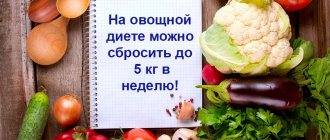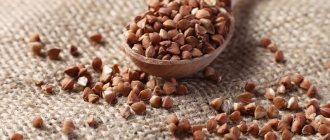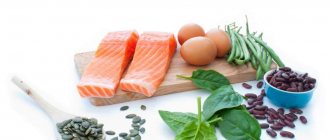February 11, 2021 Admin Home page » Important nutritional points
Are you overweight or have signs of diabetes? Learn the list of starchy and non-starchy vegetables and keep your health normal.
Plant foods, without competition, are beneficial for weight loss. After all, most plant products (except nuts) contain a reduced proportion of fat and are rich in fiber and vitamins. They improve intestinal function, accelerate the elimination of toxins and maintain metabolism at a high level.
However, people suffering from diabetes or trying to get rid of extra centimeters on their waist should not eat absolutely any product of plant origin. Not only sweet foods are subject to restrictions, but also starchy vegetables that contain harmful starch.
The importance of starch for the human body
A person should have a balanced diet filled with fats, carbohydrates and proteins. It is thanks to carbohydrates that the body receives a sufficient amount of energy, especially when consuming glucose, which is easily broken down by the gastrointestinal tract, releasing a large amount of heat.
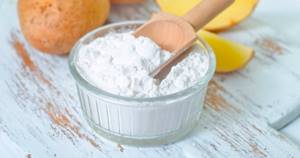
Glucose in its pure form is very rare in ingredients, so it is best to get it from starch, which can be found in excess in certain foods. The main reason why you need to eat starchy foods is to saturate your body with energy.
Starch is useful for intestinal bacteria, increasing immunity, producing gastric juice, and normalizing blood sugar levels.
However, it is necessary to regulate the level of starch to limit the amount of starch in the body. With a sedentary lifestyle and excess starch, you can gain excess weight, and in some cases this can provoke side effects such as disruption of the gastrointestinal tract, causing flatulence. It is for this reason that nutritionists advise patients to reduce their consumption of vegetables and fruits, which contain the maximum amount of starch.
The bulk ingredient can be refined or natural . The latter is usually not dangerous. It is found in vegetables, fruits, root vegetables, cereals and other products. You can gain extra pounds by eating these ingredients only if you consume the components in huge quantities or with complete immobility.
When using supplements based on refined starch, you can gain excess weight, which will be very difficult to lose if desired. Additives in the form of thickeners, which are present in some foods that are often included in the diet, can also aggravate the situation.
Whole wheat flour (57.8%)
Compared to refined flour, whole wheat flour is more nutritious and contains less starch. This makes it the best option. For example, 1 cup (120 g) of whole wheat flour contains 69 g of starch or (57.8%) (30).
Although both types of wheat flour contain the same amount of carbohydrates, whole wheat has more fiber and nutrients. This makes it a healthier option.
Summary:
Whole wheat flour is an excellent source of fiber and nutrients. One glass (120 g) contains 69 g of starch (57.8%).
Why starch is harmful
Starch is a polysaccharide that is necessary for the body. The product allows you to quickly restore strength and be completely satisfied. However, sometimes it can completely replace protein. Under the influence of enzymes, complex carbohydrates are broken down normally. At the same time, it releases glucose necessary to nourish the brain, internal organs and muscle tissue. However, starch is harmful to those people who are overweight. Therefore, its consumption must be limited.
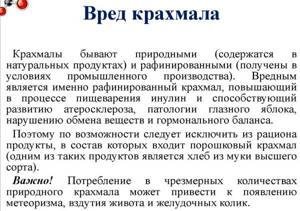
This is due to the fact that the sugar into which the raw material is converted quite heavily overloads the pancreas, thereby accelerating the accumulation of extra pounds. Moreover, after each intake of starch, insulin enters the bloodstream, which reduces glucose levels, slowing down fat metabolism.
In this regard, a huge amount of carbohydrates does not have time to be digested in a timely manner. In the future, this leads to the appearance of folds on the sides. The most dangerous type is the refined type of product. Therefore, it is advisable to exclude it from the diet.
Otherwise, you may encounter the following problems:
- vascular atherosclerosis;
- hormonal imbalance;
- vascular walls become thin;
- increased insulin level.
With constant consumption of refined starch, the stomach and pancreas begin to ache.
This is manifested by the following symptoms:
- bloating;
- digestive disorder;
- nausea with vomiting;
- suffocation.
When the condition is neglected, sneezing, nasal discharge and speech impairment appear.
Instant noodles (56%)
Instant noodles are a popular and convenient food item because they are cheap and easy to prepare. However, these noodles are highly processed and generally low in nutrients. In addition, it tends to contain large amounts of fat and carbohydrates.
For example, one packet contains 54 grams of carbohydrates and 13.4 grams of fat (31).
Most of the carbohydrates in instant noodles come from starch. The package contains 47.7 g of starch (56%). Additionally, studies have shown that people who consume instant noodles more than twice a week have a higher risk of developing metabolic syndrome, diabetes and cardiovascular disease. It is especially harmful for women (32, 33).
Summary:
Instant noodles are heavily processed and high in starch. One package contains 47.7 g of starch (56%).
Composition and types of starch
Starch is considered a complex carbohydrate containing remnants of glucose molecules. It breaks down quite poorly in liquid. However, due to this, it is able to fulfill its function - to preserve nutrients for a long period of time. Thanks to starch, plants are able to accumulate energy reserves and form small grains in greens. The hydrolysis process makes it possible to convert starchy grains into glucose.
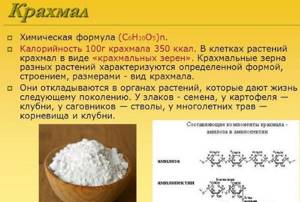
Through cell membranes they settle in various parts of the plant. Glucose is considered to be the nutrition of the sprout after it forms from the seed. When food containing starch is chewed, saliva is not completely able to break down the substance into maltose. The impact of pancreatic secretion completes its work in the walls of the small intestine.
The chemical composition of starch contains the following components:
- protein;
- water;
- fats;
- ash;
- carbohydrates.
The substance also consists of vitamins (groups B, C, E) and minerals in the form of manganese, copper, zinc, potassium, phosphorus, magnesium, iron and calcium.
The main types of starch are the following:
- Corn. It is presented in the form of an opaque light milky paste, which has a low viscosity, as well as a taste and smell characteristic of corn grains.
- Oat. It is quite often added to jelly and other products that are useful for mental and physical fatigue. Starch makes it possible to remove cholesterol, as well as improve the condition of anemia, poor sleep and diabetes.
- Wheat. Wheat-based components allow you to dilate blood vessels and dissolve salts in the genitourinary system. They can also be used for gastrointestinal diseases. For superficial use, baths with the addition of wheat starch make it possible to eliminate itching and cure childhood diathesis. Wheat starch is characterized by not too high viscosity and a transparent paste.
- Potato. This type is characterized by a high level of absorption. Compared to starch-containing grains and cereals, it transforms into the glucose state much more actively. This is due to the oily, not too thick layer that is located under the skin of young potatoes. It is often removed while peeling the vegetable. Therefore, potatoes that have been baked in their skins or boiled in their skins are of great benefit. Starch is extracted from potato tubers, forming a paste with a viscous and transparent texture.

Starchy vegetables and fruits provide raw materials. The most popular is potatoes. - Rye. This type of starch is mainly used for diabetes mellitus in order to increase resistance, binding, and also remove harmful substances.
- Rice. It contains a huge amount of starch, while it has an astringent effect. If rice cereal is cooked without adding oil and salt, it can be used to soothe, enhance lactation, improve complexion, and also for diseases associated with the genitourinary system. Round rice grains contain much more substance. As a result, the cereal boils and sticks together. Rice starch creates an opaque paste with minimal viscosity, which is characterized by high stability during storage. It is added to white sauces and puddings as a stabilizer.
3-5: Flour (68-70%)
Flour is a versatile and basic ingredient for baking and comes in different grades such as sorghum flour, millet flour, wheat flour and refined wheat flour. All of these flours also tend to contain starch. So, what foods contain starch:
Millet flour (70%)
Millet flour is made by grinding the seeds of millet, a group of highly nutritious ancient grains. 100 g of millet flour contains 70 g of starch (70%). Millet flour is also gluten-free and rich in magnesium, phosphorus, manganese, and selenium (14).
Although millet contains a ton of nutrients, there is some evidence that consuming it may interfere with normal thyroid function. However, the effects in humans are unclear, so more research is needed (15, 16, 17).
Sorghum flour (68%)
Sorghum is an ancient nutritious grain (cereal) that is ground into sorghum flour. 100 g of sorghum flour contains 68 g of starch (68%). Despite its high concentration, sorghum flour is a much better choice than most flours. This is because it is gluten-free and an excellent source of protein and fiber. 100 g of sorghum flour contains 8 g of protein and 6.3 g of fiber (18).
In addition, sorghum is an excellent source of antioxidants such as policosanol. Research has shown that these antioxidants may help reduce insulin resistance, lower blood cholesterol, and may have antitumor properties (19, 20, 21).
Find out in detail about what sorghum is and what benefits its use can bring - Sorghum: what it is, benefits and harm.
White flour (68%)
Whole wheat grains have three key components. The outer layer is known as the bran, the germ is the reproductive part of the grain, and the endosperm is its nutrition.
White flour is made by removing the bran and germ, which are rich in nutrients and fiber (22).
Only the endosperm is left, which is ground into white flour. It tends to be low in nutrients and mostly empty calories (23).
In addition, due to the fact that the basis of white flour is endosperm, it contains a large amount of starch. 100 g of white flour contains 68 g of starch (68%) (24).
Summary:
Millet flour, sorghum flour and white wheat flour are popular flours with similar starch content. Of all these three types, sorghum flour is the healthiest, while white wheat flour is the most unhealthy and should be avoided.
Rules for using products
Starchy vegetables and fruits (the list of ingredients will explain how to properly consume foods with maximum and minimum amounts of starch) must be eaten, following the rules of a harmonious combination of food components, so that food intake does not become a factor in the appearance of adipose tissue.
Containing starch
A person who controls his body weight can easily reduce his consumption of starchy foods. However, this does not mean that they must be abandoned completely.
When dieting, the following generally accepted rules must be taken into account:
- Potatoes and legumes should be combined with fresh tomatoes, red or white cabbage, and cucumbers.
- It is not advisable to supplement starch with other ingredients. It is best to combine the components with each other.
- Fruits and vegetables that contain starch go well with any greens.
- In order for carbohydrates to be digested and fully absorbed, the diet will need to be diversified with components that contain a large amount of B vitamins.
- It is recommended to bake starchy ingredients or steam them.

To prevent the body from experiencing a shortage of macro- and microelements it needs, it is recommended to include ingredients containing starch in your menu. Nutritionists also advise supplementing products with light fats. These include a refined type of sunflower oil, liquid cream with a small amount of fat and sour cream. Thanks to this combination, carbohydrates are more quickly absorbed and converted into energy that a person uses per day.
The source of energy is usually carbohydrate foods. Therefore, in order to use it up, it is recommended to take these products in the afternoon. After this, you will need to stop taking carbohydrates, and give preference to components with a large amount of protein. This is especially necessary for people who are actively involved in sports.
Non-starchy
Due to the fact that non-starchy vegetables have a low calorie content, they are called negative calorie foods, since when broken down they produce fewer calories than the body needs to digest them. It is not without reason that these ingredients are recommended to be consumed together with heavy foods such as meat, fish or cereals. Non-starchy vegetables are often added as a filling when baking a pie or minced meat casserole.
These ingredients make excellent dietary dishes in the form of soups and salads. Despite the fact that fast food contains a large amount of trans fats, a small slice of cucumber and a leaf of lettuce are still added to it to at least slightly help the body digest this food. It is not recommended to combine milk with non-starchy foods, as this can trigger the fermentation process in the intestines.
It is permissible to combine and eat such foods because they help:
- fill the stomach and not give a feeling of heaviness;
- get rid of rotting processes;
- give a feeling of saturation;
- move food through the gastrointestinal tract.
Due to the fact that such products contain few calories, they can be added to food at night.
Pasta from durum wheat (26%)
Durum wheat pasta comes in many forms, such as spaghetti, macaroni, vermicelli, fettuccine, etc. As with rice, pasta reduces the amount of starch when cooked because it gelatinizes when heated in water. For example, dry spaghetti contains 62.5% starch, while cooked spaghetti contains only 26% of this polymeric carbohydrate (45, 46).
Summary:
Pasta contains 62.5% starch in dry form and 26% in cooked form.
Dividing vegetables and fruits according to the amount of starch
Starchy vegetables and fruits (the list of ingredients will explain how foods are divided by starch volume) include complex carbohydrates, which turn into glucose during digestion. At the same time, starch is considered one of the most common types of polysaccharides. That is why the classification of components into starchy and non-starchy at the very beginning belongs to the theory of a separate menu and is used when designing a healthy nutritional diet.

Non-starchy vegetables are considered essential for weight loss. However, starchy ingredients must be avoided. The presence of excess fast carbohydrates in the diet causes you to gain extra pounds. If you pay attention to their volume, it will be possible to regulate the calorie content of all dishes.
The largest volume of starch is contained in roots and grains with large particles, which retain nutrients for the supply and germination of the plant embryo. It is believed that the largest proportion of starch is found in potatoes, but this is not considered true. Nutritionists do not recommend eating potatoes in large quantities, but you shouldn’t give them up completely.
It is in this regard that you need to know moderation in everything, since excess food and overeating can lead to gaining extra pounds. Components including starch should be taken into food whenever possible, using non-starchy green vegetables with vegetable and animal fats, while excluding negative compounds with proteins, sugar and acid. You should consume one type of starchy ingredient at a time.
The main component of the menu for weight loss is non-starchy ingredients. Cauliflower, on the one hand, is a moderately starchy component in dietary terms. But, on the other hand, it is recommended to use it together with fats.
It is necessary to take into account that eggplant does not belong to non-starchy, but to moderately starchy ingredients.
Tomatoes, on which the tomato diet is based, are neither of those, despite the fact that the vegetable is considered a salad ingredient. Due to the huge volume of citrus, malic and oxalic acid in tomatoes, they cannot be included in foods with starchy ingredients. However, it is acceptable with leafy foods and fats.
Rice (28.7%)
Starchy foods include rice, which is the most commonly consumed staple food in many countries around the world (41).
It contains a large amount of starch, especially when raw. For example, 100 grams of raw rice contains 80.4 grams of carbohydrates, of which 63.6% are starch (42).
However, when rice is cooked, the content of this polymeric carbohydrate decreases sharply. In the presence of heat and water, starch molecules absorb water and swell. Eventually, this swelling breaks down the bonds between starch molecules in a process called gelatinization (43).
Thus, 100 g of cooked rice contains only 28.7% starch because cooked rice contains much more water (44).
You can learn more about the beneficial properties of rice and its nutritional value on this page - Rice: benefits and harm to human health.
Summary:
Rice is the most commonly consumed staple food worldwide. When cooked, its starch content decreases dramatically because its molecules absorb water and are broken down during the cooking process.
The starchiest
Starchy vegetables and fruits, entering the stomach, are able to break down into glucose in a relatively short time interval, thereby increasing the blood sugar level. As a result, this increases the feeling of hunger.
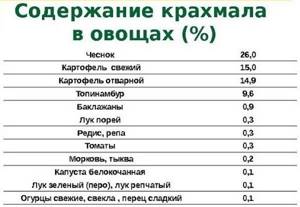
In this regard, it is undesirable to abuse such food. However, in order for the muscles to always be in good shape and the brain to function fully, the body requires glucose. To independently control the amount of starch consumed, it is recommended that you familiarize yourself with the list of ingredients that contain the described component.
Vegetables
Starchy vegetables and fruits (the list of ingredients will tell you which ingredients contain the most starch) can benefit the body if they are consumed correctly and combined with other ingredients.
Table of vegetables containing the maximum amount of starch:
| Ingredient name | Per 100 g of raw materials, the volume of starch is indicated in g |
| Potato | 18,2 |
| Swede | 18 |
| Radish | 15 |
| Beet | 14 |
| Jerusalem artichoke | 9,6 |
| Corn | 4.0 g |
| Pumpkin with garlic cloves | 2 |
| Parsley leaves | 1,2 |
| Eggplant | 0,9 |
| Celery root | 0,6 |
| Cabbage | 0,5 |
| Radishes with turnips | 0,3 |
| Carrot | 0,2 |
| Onion with cucumber and bell pepper | 0,1 |
Fruits
Starchy vegetables and fruits (the list of ingredients will indicate which fruits are rich in starch) can saturate the body and eliminate hunger, but only if eaten in moderation.

The table shows a list of fruits that contain starch:
| Product name (100 g) | Starch volume (g) |
| Banana | 7 |
| Apple | 0,8 |
| Black currant | 0,6 |
| Pear | 0,5 |
| Strawberry | 0,1 |
| Plum | 0,1 |
A list of starchy foods allows those on a diet to follow the rules of eating vegetables and fruits. This is necessary in order to get maximum benefit and positive results from the weight loss process.
Corn flour (74%)
Cornmeal is a type of coarse meal made by grinding dried corn kernels. It does not contain gluten (gluten), which makes it safe for people with celiac disease.
Although cornmeal contains some nutrients, it is very high in carbohydrates and starch. 100 g of corn flour contains 79 g of carbohydrates, of which 74 g (74%) is starch (8).
You can learn more about corn flour on this page - Corn flour: benefits and harm.
Summary:
Corn flour is a gluten-free flour made from dried corn kernels. 100 grams of this flour contains 74 g of starch.
Non-starchy vegetables: complete list
| Eggplant |
| Broccoli |
| Brussels sprouts |
| Mustard |
| Green pea |
| Beijing (Chinese) cabbage |
| Kohlrabi |
| Cabbage (white cabbage, red cabbage, savoy cabbage, garden cabbage, fodder cabbage) |
| Watercress and watercress |
| Asparagus |
| Summer squash (oblong yellow) |
| Lettuce and other types of lettuce |
| Turnip tops and other above-ground green parts of edible plants |
| Beet leaves and swiss chard |
| Onions (onions, shallots, leeks, chives, leeks) |
| Cucumber |
| Dandelion greens |
| Okra |
| Okra |
| Parsley (greens) and other table herbs |
| Bamboo shoots |
| Crescent (greens) |
| Celery (greens) |
| Bell pepper |
| Chicory |
| Garlic (greens and cloves) |
| Spinach |
| Sorrel |
Potatoes (18%)
Potatoes are incredibly versatile and are a staple food in many households around the world. When it comes to starchy foods, potatoes are often the first thing that comes to mind. Interestingly, potatoes do not contain as much starch as flour, baked goods or cereals, but they do contain more of this carbohydrate compared to other vegetables.
For example, a medium baked potato (138g) contains 24.8g starch (18%).
Potatoes are an excellent part of a balanced diet because they are a good source of vitamin C, vitamin B6, folate, potassium, and manganese (49).
You can learn more about the beneficial properties of potatoes and the potential harm from consuming them on this page - Potatoes: benefits and harm to the human body.
Summary:
Although potatoes are richer in starch than most vegetables, they also contain many vitamins and minerals. This is why potatoes are still a great part of a balanced diet.
Corn (18.2%)
Starchy foods include corn. Corn is one of the most widely consumed grain crops. They also have the highest starch content of any whole vegetable (47).
For example, 1 cup (141 g) of corn kernels contains 25.7 g of starch (18.2%). Although it is a starchy vegetable, corn is very nutritious and is a great addition to your diet. It is especially rich in fiber, as well as vitamins and minerals such as folic acid (vitamin B9), phosphorus and potassium (48).
You can learn more about the benefits and harms of corn here - Corn: health benefits and harms, calorie content.
Summary:
Although corn contains a lot of starch, it is very healthy due to the presence of fiber, vitamins and minerals. One cup (141 g) of corn kernels contains 25.7 g of starch (18.2%).
